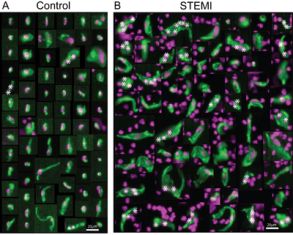New blood test predicts heart attack risk
26 March 2012
A new blood test to detect misshapen blood vessel cells may be useful in helping doctors predict who is at risk of an imminent heart attack.
The landmark study, led by Scripps Translational Science Institute (STSI), found that circulating endothelial cells (CEC) from heart attack patients were abnormally large and misshapen and often appeared with multiple nuclei. This indicates that CECs are promising biomarkers for the prediction of acute ongoing arterial plaque rupture.
"The ability to diagnose an imminent heart attack has long been considered the holy grail of cardiovascular medicine," said Dr. Eric Topol, the study's principal investigator and director of STSI. "This has been a tremendous collaboration of two institutions on the research side, three health care systems in San Diego, and a life science industry leader, which has resulted in an important discovery that may help to change the future of cardiovascular medicine."
The study involved 50 patients who presented to emergency rooms with heart attacks at four acute care hospitals in San Diego. Using different cell isolation platforms, including the Veridex CellSearch System, the researchers found that CEC counts and the cell structural features were dramatically altered in the heart attack population when compared to the healthy control group.

Normal circulating endothelial cells are on the
left. The unique appearance of circulating endothelial cells in
heart attack patients (right) may make them predictors of imminent
heart problems.
"We are pleased to have collaborated on this important investigational study, said Dr Mark Connelly, Director, Cellular Research, Veridex. "CellSearch has proven to be a powerful tool for oncology research and the care of metastatic cancer patients. This study highlights the value of accurate rare cell capture and analysis in areas beyond oncology."
"When Palomar Health was approached to participate in a research study involving this population, we were quick to recognize the potential value of this work," said Palomar Health Director of Interventional Services Paul Patchen, RN. "We were honoured to have been able to contribute to this groundbreaking research that may have significant benefit not only to our patients and community but to all patients with coronary artery disease."
The findings are significant, as more than 2.5 million US individuals experience a heart attack or ischemic stroke, most commonly the result of obstructive coronary artery disease, according to Paddy Bennett, MD, lead investigator at STSI. If the arteries get abruptly and completely occluded by the buildup of fatty cholesterol, it will cause a massive heart attack that will likely lead to a sudden death, as was the case involving former NBC News Washington Bureau Chief Tim Russert.
"With some additional validation, the hope is to have this test developed for commercial use in next year or two," said Raghava Gollapudi, MD, who was the principal investigator from Sharp HealthCare. "This would be an ideal test to perform in an emergency room to determine if a patient is on the cusp of a heart attack or about to experience one in the next couple of weeks. Right now we can only test to detect if a patient is currently experiencing or has recently experienced a heart attack."
More information
Results of the study, titled Characterization of Circulating Endothelial Cells in Acute Myocardial Infarction, were published in Science Translational Medicine.
The study was co-authored by physicians and scientists from Scripps Health; STSI; TSRI; Veridex, LLC (a Johnson & Johnson company); Palomar Health; and SharpHealthCare. Funding came from a $2 million grant from the National Institutes of Health.
Scripps Translational Science Institute (STSI) is a collaborative program between Scripps Health and The Scripps Research Institute (TSRI).